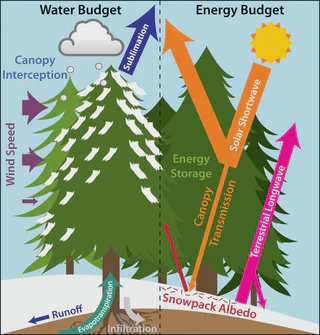Impact of forest disturbances on snow dynamics
Oct 5, 2025· ·
0 min read
·
0 min read
John Mohd Wani
 Image credit: Evan Crouch
Image credit: Evan CrouchAbstract
In response to climate warming and declining snowpack, there is an increase in the frequency of large forest disturbances, such as fires, insects, or wind damage around the world. In turn, these forest disturbances impact the snowpack dynamics by altering the canopy cover, surface albedo, and the surface energy budget. The impact of forest disturbances on snowpack is persistent and widespread and in-turn have a significant impact on snow accumulation and snowmelt. Depending on climate conditions, the occurrence of forest disturbance and associated canopy removal could accelerate or delay snowmelt, and often snowmelt models do not properly represent those processes. Since snow is an important part of mountain hydrology, such changes will have a significant impact on water supply for agriculture, domestic use, and hydropower generation. In this study, we aim to investigate the impact of forest disturbances on key snowpack processes such as accumulation, ablation, and runoff. We aim to employ a range of models, from simple lumped (e.g., GEOframe modelling system) to physically-based and spatially-distributed models (e.g., GEOtop and SnowModel). The analysis will be conducted at two distinct study sites: one in the Western United States (Santiam River Basin, Oregon), where recent forest fires are extensive and another in the European Alps (upper Adige catchment) where in 2018 forests have been affected by widespread wind damage. This intercomparison will highlight the importance of model selection and parameterization complexity in analyzing the impacts of forest disturbance on snowpack dynamics. Additionally, this will improve our understanding of the impacts on downstream runoff in snow-dominated forested watersheds.
Date
Oct 5, 2025 12:00 AM — Oct 10, 2025 12:00 AM
Event
Location
Roorkee, India